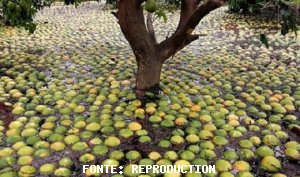 See photos
See photos
Piracicaba, 19 – Hurricane Irma, which hit Florida on September 10, should damage the local citrus groves. Since it reached a wide area, all citrus producing regions should be affected, mainly central and southwestern state.
In an interview for ABC News, the executive director of the Florida Citrus Department, Shannon Stepp, said that production was likely to surpass 75 million boxes, as estimated by Elizabeth Steger before the hurricane hit. Now, the director expects numbers to decrease sharply.
There are no official estimates regarding the damages caused by Irma hurricane yet, but the press has reported damages between 10% and 80%, depending on the area and the variety. The press has also released reports from local growers estimating damages at 1.2 billion USD to the agricultural production, including citrus, sugarcane, tomatoes, green beans, cucumber and others. Besides, fruits and trees drops were observed, as well as floods in citrus groves from Florida.
ORANGE JUICE – At the New York Exchange Stock (ICE Futures), the future contracts of Frozen Concentrate Orange Juice (FCOJ) due in November/17 increased in the second week of September, with the announcement of hurricane Irma by the United States. Thus, between September 5 and 12, values rose 19.12%, averaging 2,191.59 USD per ton.
In this scenario, citrus growers from all over the world are focused on the impacts of Irma hurricane on global demand for orange juice. For Brazil, that scenario would only reinforce the need of importation from the United States, since inventories from North-American processors are low. Therefore, a larger crop in the citrus belt from São Paulo may help Brazil to meet that demand.
According to the last report from Fundecitrus (Citrus Defense Fund), released on September 11, the 2017/18 crop was estimated at 374.06 million 40.8-kilo boxes in São Paulo and Triângulo Mineiro. That volume is 2.63% larger than that first estimated in May, and 52.5% higher than that in the previous season (2016/17), which ended with 245.3 million boxes. This inventory increase was favored by rains in the first semester (April to June/17), which boosted fruits growth, mainly for the early fruits, whose harvest had reached 75% of the total area in mid-July.
DOMESTIC MARKET – Warmer weather in São Paulo State boosted demand for in natura oranges in the first fortnight of September. Drier weather, on the other hand, affected the quality of the fruits in some regions, mainly where the volume of rains was low. Between September 1 and 15, pear orange quotes averaged 16.34 BRL per 40.8-kilo box, on tree, 1.1% down compared to the average in the first fortnight of August.
TAHITI LIME – The scenario is positive for tahiti lime as well. Besides higher domestic demand, the volume of fruits ready to be harvested continued reduced. Thus, prices increased in the first fifteen days of the month. Between September 1 and 15, quotes averaged 51.73 BRL per 27-kilo box in SP, harvested, 15.5% up compared to that in the same period last month.
Source: hfbrasil.org.br